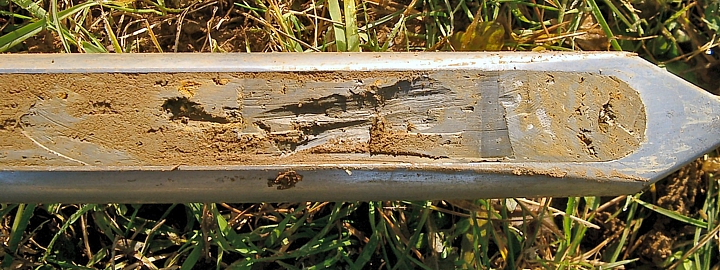 |
| Basic Concepts | Projects | Work by others | Pictures | References |
| |
| Biochar Projects |
| Currently (April 2011) we conduct experiments to evaluate the effects of biochar on crop yield, nutrient adsorption, nutrient leaching, nitorgen cycles, dynamics of nitrous oxide and methane, water percolation, soil water availability and carbon cycling as well as the stability and mobility of biochar itself with research in our Ithaca lab, in field experiments in the U.S. and Kenya, and through collaborators in China and Paraguay. We have largely completed our work in Colombia, Brazil, and Zambia. |
| |
| Biochar as part of a village-scale bioenergy system |
| Laboratory and Field Experiments, since 2010:
|
| This project takes a comprehensive view at the entire biochar system, to generate transportation fuels, biochar, reduce greenhouse gas emissions and improve livelihoods in developing countries. More information is available on a dedicated website. |
Funding:
Gift by Mr Yossie Hollander; NSF IGERT; Cornell Graduate School |
| |
| Biochar-Inoculants to Enable Agricultural Development |
| Laboratory and Field Experiments, since 2010:
|
| This project looks at opportunities to optimize biochars as inoculant carriers to improve storage, survival and inoculation of crops with beneficial microorganisms such as rhizobia, myorrhizae or trichoderma. The project also develops basic modeling tools for stove optimization, designs and tests stoves for emissions and adoption in Kenya. More information is available on a dedicated website. |
Publications:
Whitman T, Nicholson CF, Torres D, Lehmann J 2011 Climate change impact of biochar cook stoves in Western Kenyan farm households: System dynamics model analysis. Evironmental Science and Technology : in press.
|
Funding:
NSF-BREAD: Basic Research to Enable Agricultural Development (co-funded program between NSF and The Bill and Melinda Gates Foundation), NSF-IGERT; Cornell Graduate School |
| |
| Biochar as an amendment to improve soil fertility and nutrient retention |
| Laboratory Experiments, since 2001: |
Changes of biochar properties and effects on soil fertility were monitored as influenced by biotic and abiotic processes and additions of inorganic and organic fertilizers. Results indicate that abiotic processes are more important than hypothesized in increasing cation exchange capacity of biochar surfaces.
In addition, biochar at sites of historic charcoal production dating from the mid 19th century are investigated for their effects on nutrient retention. Particular interest is to understand the effects of mean annual temperature on biochar oxidation, as samples were taken from historic sites stretching from Quebec to Alabama. Biochars were had greater adsorptive properties for cations through surface oxidation than through adsorption of organic matter. While fresh biochar had little adsorptive capacity, aged biochar showed very high cation exchange capacity, to a greater extent with increased mean annual temperature. Stability of biochar remaining in soil after 130 years was not affected by mean annual temperature, providing insight into the mechanism of biochar decomposition. |
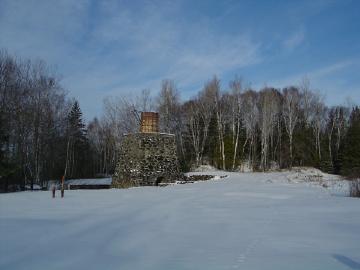
(Biochar sample sites in storage areas for iron furnaces, Photo C. Cheng) |
Publications:
Cheng CH, Lehmann J, Thies JE, Burton SD and Engelhard MH 2006 Oxidation of black carbon by biotic and abiotic processes. Organic Geochemistry 37: 1477-1488.
Cheng CH, Lehmann J and Engelhard M 2008 Natural oxidation of black carbon in soils: changes in molecular form and surface charge along a climosequence. Geochimica et Cosmochimica Acta 72, 1598-1610.
Cheng CH, Lehmann J, Thies JE and Burton S 2008 Stability of black carbon in soils across a climatic gradient. Journal of Geophysical Research (Biogeosciences) 113, G02027.
Cheng CH and Lehmann J 2009 Ageing of black carbon along a temperature gradient. Chemosphere 75: 1021-1027. |
Funding:
McIntire-Stennis Funds of USDA, Clean Air Task Force, Kiekhefer Foundation, Taiwanese Government Scholarship for C. Cheng |
| |
| Field Experiments Ithaca, USA, since 2007: |
| Field experiments were initiated to investigate the effects of biochar produced from corn stover on crop production and nutrient dynamics. The study examines the impact of (1) the amount of biochar added; (2) the amount of nitrogen fertilizer; (3) applying annual versus one-time applications; and (4) banded versus broadcast application. |

(Field installation for biochar trial, Photo: C. Hyland) |
Funding:
USDA-Hatch McIntire Stennis |
Publications:
Guerena D, Lehmann J, Hanley K, Enders A, Hyland C 2013Nitrogen dynamics following field application of biochar in a temperate North American maize-based production system.Plant and Soil 365: 239-254. |
| Greenhouse Experiments Cali, Colombia, 2002-2003: |
| Greenhouse experiments are being conducted in a collaboration with Dr. Marco Rondon, TSBF CIAT (Tropical Soil Biology and Fertility Programme at the Centro Internacional de Agricultura), Cali, Colombia, to test the effect of biochar applications on biological N fixation, soil fertility improvement, dinitrous oxide and methane emissions and growth of cerials, pasture as well as high-value horticultural crops in Colombia. |
Publications:
Rondon M, Lehmann J, Ramírez J and Hurtado M 2007 Biological nitrogen fixation by common beans (Phaseolus vulgaris L.) increases with bio-char additions. Biology and Fertility in Soils 43: 699-708. |
Funding:
USAID Linkage Grant, CIAT-TSBF |
| |
| Field Experiments Cali, Colombia, 2002-2006: |
| Field experiments were conducted in a collaboration with Dr. Marco Rondon, TSBF CIAT, Cali, Colombia, to study soil nutrient availability and leaching in acid soils as affected by biochar applications over four years, as well as the fate of biochar when applied to soil. Sites around Cali as well as in the savanna region of Colombia were chosen. Studies show significant yield increases of maize, improved pasture and native savanna. We monitored water percolation and nutrient leaching as well as mineralization and leaching of biochar itself. |

Maize growth of a biochar trial in Colombia, Photo: J. Major) |
Publications:
Major J, Lehmann J, Rondon M and Goodale C 2010 Fate of soil-applied black carbon: downward migration, leaching and soil respiration. Global Change Biology 16: 1366-1379.
Major J, Rondon M, Molina D, Riha S and Lehmann J 2010 Maize yield and nutrition during 4 years after biochar application to a Colombian savanna oxisol.Plant and Soil 333, 117-128. |
Funding:
USAID Linkage Grant, Mellon Foundation, Cornell Graduate School Research Support, BEB IGERT, Canadian Government Graduate Student Stipend, Center for the Environment at Cornell University |
| |
| Graduate Student Stipend, Center for the Environment at Cornell University, Field Experiments Eastern Provinces, Zambia, since 2006: |
| Field experiments were started in a collaboration with COMACO and WCS to evaluate the effects of rainfall and soil type on the benefits that biochar offers in conservation agriculture. |
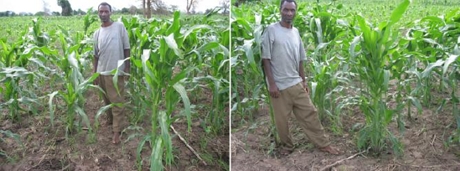
(Maize growth with biochar (right) in comparison to only fertiliser (left) in Zambia, Photo: L. Gatere) |
Funding:
USAID SANREM, Bradfield Award |
| |
| |
| Soil organic matter properties and greenhouse gas emissions after biochar applications to soil |
| Field Experiments Ithaca, USA, since 2007: |
| Field experiments with biochar produced from corn stover applied to corn were used to quantify the dynamics of methane and nitrous oxide evolution from soil. |
Publications:
Hanley et al, in preparation. |
| Funding: USDA-Hatch McIntire Stennis |
| |
| Greenhouse Experiments Cali, Colombia, since 2002: |
| In a collaboration with Dr. Marco Rondon, TSBF CIAT, greenhouse gas emissions were monitored by Dr. Rondon's group to assess the impact of biochar on N2O and CH4 emissions, as well as the stability of biochar and leaching of DOC into the subsoil. Biochar obtained from C-3 plants was applied to savanna soil that is dominated by C-4 grasses, which allowed the tracing of the fate of applied biochar.
|
| Funding: USAID Linkage Grant, CIAT-TSBF |
|
| |
| Field Experiments Cali, Colombia, since 2002: |
Field experiments are being conducted to evaluate the stability of biochar in soil and change of properties. Greenhouse gas emissions (N2O and CH4) have been studied for one season. Future studies will include carbon dioxide emissions and leaching of DOC in grasslands.
|
| Funding: USAID Linkage Grant, Mellon Foundation, Cornell Graduate School, BEB IGERT, Canadian Government, Center for the Environment at Cornell University |
Publications:
Major J, Lehmann J, Rondon M and Goodale C 2010 Fate of soil-applied black carbon: downward migration, leaching and soil respiration. Global Change Biology 16: 1366-1379. |
| |
| Field Experiments, Western Kenya, since 2005: |
| The carbon balance and stabilization of biochar was studied in comparison to other organic additions such as animal manure, green manure and sawdust. |
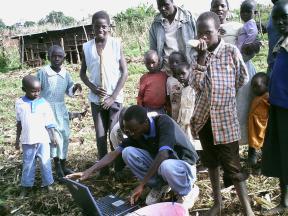
(Measuring carbon dioxide gas exchange in fields amended with biochar, Photo: J. Kimetu) |
Publications:
Kimetu JM and Lehmann J 2010 Stability and stabilization of biochar and green manure in soil with different organic carbon contents. Australian Journal of Soil Research 48: 577–585. (supporting online information) |
| Funding: Rockefeller Foundation, National Science Foundation, First Presbyterian Fund |
| |
| |
| Mitigation of Soil Degradation with Biochar |
| Field Experiments, Western Kenya, since 2005: |
| Biochar was added to agricultural fields of soils along a degradation gradient which resulted from different lengths of continuous maize cultivation. We address the question at what stage of soil degradation are biochar applications the most effective. Results indicate that applications in the most degraded sites increase yields the most. Increases could not solely explained by better plant nutrition, suggesting effects related to improved water availability, soil penetrability or microbial dynamics. The results showed doubling of crop yield in the highly degraded soils from about 3 to about 6 tons/ha maize grain yield (Kimetu et al., 2008). In consecutive years, no biochar was applied. |
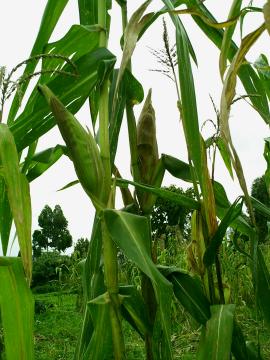
(Maize trials Photo: J. Kimetu) |
Publications:
Kimetu J, Lehmann HJ, Ngoze S, Mugendi D, Kinyangi J, Riha S, Verchot L, Recha J and Pell A 2008 Reversibility of soil productivity decline with organic matter of differing quality along a degradation gradient. Ecosystems 11: 726-739. |
Funding:
Rockefeller Foundation, National Science Foundation, First Presbyterian Fund |
| |
| |
| Biochar and Bio-energy |
| Laboratory Experiments Ithaca, since 2006: |
| Biochar from different production procedures and different feedstocks are examined for their properties with respect to nutrient retention and carbon stability. |
Funding:
McIntire-Stennis Funds of USDA, Clean Air Task Force (Boston), NYSERDA (New York State Energy Research and Development Agency) |
| |
| Desk Study and Modeling Ithaca, USA, since 2006: |
| This study starts to explore the energy and carbon budget of low-temperature pyrolysis in combination with a biochar application to soil. It quantifies the emissions associated using a range of bioenergy crops such as miscanthus, switch grass, and corn, as well as crop residues of corn and wheat. Results show that biochar applied to soil reduces greater amounts of greenhouse gas emissions than if the biochar were to be used to off-set fossil fuel. Significant scope for emission reductions was identified for New York State. Different case studies are being developed. |
Funding:
USDA-Hatch McIntire Stennis, NYSERDA |
Publications:
Gaunt J and Lehmann J 2008 Energy balance and emissions associated with biochar sequestration and pyrolysis bioenergy production. Environmental Science and Technology, in press. (print proof)
Lehmann, J.: 2007, 'A handful of carbon', Nature 447, 143-144.
Lehmann, J.: 2007, 'Biochar for mitigating climate change: carbon sequestration in the black', Forum Geooekologie 18 (2), 15-17.
Roberts K, Gloy B, Joseph S, Scott N and Lehmann J 2010 Life cycle assessment of biochar systems: Estimating the energetic, economic and climate change potential. Environmental Science and Technology 44: 827–833. |
| |
| |
| Biochar as an amendment to improve soil fertility and nutrient retention |
| Greenhouse Experiments Manaus, Brazil, 2000-2001: |
Greenhouse experiments were conducted with rice and cowpea using closed and open systems (allowing the determination of leaching) at the Embrapa Amazonia Ocidental, Manaus, Brazil. (Collaborator: Jose Pereira da Silva Jr.)
Abstract. The study tested whether biochar additions were able to improve crop growth and nutrition as well as reduce nutrient leaching. In the first experiment, cowpea (Vigna unguiculata (L.) Walp.) was planted in pots, while in the second experiment lysimeters were used to quantify water and nutrient leaching from soil cropped to rice (Oryza sativa L.). Bio-char additions significantly increased plant growth and nutrition. While foliar N concentrations decreased, uptake of P, K, Ca, Zn, and Cu by the plants increased with higher bio-char additions. Leaching of applied fertilizer N was significantly reduced by biochar, and Ca and Mg leaching was delayed. |
Publications:
Lehmann J, da Silva Jr. JP, Steiner C, Nehls T, Zech W and Glaser B 2003 Nutrient availability and leaching in an archaeological Anthrosol and a Ferralsol of the Central Amazon basin: fertilizer, manure and charcoal amendments. Plant and Soil 249: 343-357.
(see also the publication in the proceedings of the 17th World Congress of Soil Science) |
| |
| Field Experiments Manaus, Brazil, 2000-2002: |
Field experiments were initiated at the Embrapa Amazonia Ocidental, Manaus, Brazil, in late 2000. Treatments included slash-and-burn, slash-and-mulch, applications of mineral fertilizer, compost, chicken manure, charcoal, and combinations in five replicates. Results indicate an emergent benefit of biochar applications in combination with mineral fertilizer for crop production of sorghum after three cropping seasons. In addition, species composition and growth of spontaneous vegetation was assessed.
(principal investigator: Wolfgang Zech, University of Bayreuth; local coordinator: Christoph Steiner and Thomas Nehls; collaborator: Wenceslau Teixeira) |
Publications:
Major J, Steiner C, DiTommaso A, Falcão NPS and Lehmann J 2005 Weed composition and cover after three years of soil fertility management in the central Brazilian Amazon: compost, fertilizer, manure and charcoal applications. Weed Biology and Management 5: 69-76.
Steiner C, Teixeira WG, Lehmann J and Zech W 2004 Microbial response to charcoal amendments of highly weathered soils and Amazonian Dark Earths in Central Amazonia – preliminary results. In: Glaser B and Woods WI (eds.) Amazonian Dark Earths: Explorations in Time and Space, Springer, Berlin, Germany. pp. 195-212.
Steiner C, Teixeira WG, Lehmann J, Nehls T, Macedo JLV, Blum WEH and Zech W 2007 Long term effects of manure, charcoal and mineral fertilization on crop production and fertility on a highly weathered Central Amazonian upland soil. Plant and Soil 291: 275-290 . |

